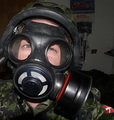Oh dear, Bernoulli again. Like Langeweische, I agree that the pressure differential due to differences in velocity above and below the wing does indeed happen, but a wing produces lift primarily by forcing air down and back... and as Newton pointed out, there is an equal reaction for every action. Air flows down and back; wing tries to go up and forward. The ram-air (not Bernoulli-induced) pressure buildup under a tilted plane moving through the air is a factor also, but the action of the upper surface is more important.
If this were not true, then how could an airfoil with a cambered top and flat bottom be flown upside down? Sure, the region of turbulence on the upward-facing surface of the wing would cause the air above it to curve a bit, but that turbulence would create a little more drag...it's important that the air curve over that surface on its way aft (see Coanda Effect), but that's because a sufficient volume of air at a sufficient velocity must keep spilling down and back from the training edge in a coherent stream in order for the wing to produce lift. And what about the bottom of this inverted wing, which is curved? What does Bernoulli make of that?
There are airfoils that are cambered on the top and bottom, in order to make inverted flight more efficient... how could they work with Bernoulli's priciples only if the lower side of the wing is not flatter than the top, eh? Discounting Bernoulli's theorem, you can see that with the right angle of attack, the wing, whether it's a standard or symmetrical airfoil, forces the air down and back as Coanda illustrated, and this action produces a lifting effect as Newton proved. Of course, thanks to the Coanda effect, the air flowing past a cambered mower surface might produce a negative-lifting effect as the curve of the wing forces it up and back, but it doesn't, generally, because of the angles involved, as well as the fact that flat or curved, and inclined plane moving through the air compresses air beneath it. There's your high pressure, which compensates for any pproblems caused by a curved wing bottom trying to throw air up and back. If it were only about pairs of molecules separating to take different paths past the wing, this wouldn't work nearly as well as it does.
I know Bernoulli's ideas are gospel in many aviation textbooks, and Newton and Coanda are ignored, but ithe Bernoulli Effect, while real, I guess, just ain't the thing that does the trick. There is in fact a pressure differential between the top and bottom of a wing in flight, but it's not the primary factor. I think the aerospace community has latched onto Bernoulli just to be different; he is their boy, and other disciplines don't need his theorem as much.
I can't quote the mathematics here, but trust me, It's Newton and Coanda who keep your plane in the air, not Bernoulli.

And most importantly, as a pilot I have found it much more sensible to think of this wing that's keeping my ass in the air as simply washing air down and back while compressing it a little beneath, rather than picturing molecules racing along different paths to meet in the same place.
To quote Langeweische:
Trying to understand the piloting of airplanes by concentrating on Bernoulli and Prandtl is like trying to catch on to tennis by studying just exactly how the rubber molecules behave in a tennis ball when the bal hits the court and just how the catgut behaves in the racket when the bal strikes: instead of simply observing that it bounces!
 Bar by Mees
Bar by Mees




 (Please discard my previous post
(Please discard my previous post  )
)







 There was a HUGE calculus formula (im taking calculus BC next year)
There was a HUGE calculus formula (im taking calculus BC next year)
 Bar by Mees
Bar by Mees












